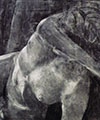May
Future doctors draw a lesson from art

Medical students at Newcastle University have turned to art to get a better understanding of how the human body is put together.
Following in the footsteps of Leonardo da Vinci, who famously produced hundreds of drawings of studies of the human anatomy, the group of 20 students have produced more than 50 artworks for an exhibition that opens next week at Newcastle’s Life Science Centre.
The project came about when Dr Iain Keenan, Lecturer in Anatomy at the Anatomy and Clinical Skills Centre, part of the University’s School of Medical Education, met Rachael Allen, a professional visual artist who specialises in medicine, human health and anatomy.
Working with a group of medical and biomedical students, they created Artatomy - a project involving structured lessons and drawing workshops aimed at enhancing the students’ learning of anatomy. Students were invited to use visual arts methods in anatomy lessons, including cadaveric specimen drawing, interpretations of clinical images such as MRI scans, and drawing from anatomy models.
Iain explains: “Many people learn better when they can see something in practice, as opposed to just reading about it. Through the process of drawing - of looking critically and reflecting on something that is in three dimensions - students are improving their knowledge and understanding of the anatomy.
“But the key point about the Artatomy project is that it’s about learning through creativity and interpretation, not by producing a diagram, and that’s why it was important to have the support and guidance of a professional artist available.”
Rachael Allen adds: “It has been really rewarding working with the students at Newcastle University and giving them the chance to explore their creative side on their own terms. Artatomy has helped them re-connect with the process of drawing that they may not be using much in their studies or in their day to day life – and in some cases haven’t used since they were at school.
“The artwork they’ve produced is rich in imagination, skill and expression, and has exceeded all expectations. It’s really indicative of the true potential and value of art when students are given the choice to explore and participate.”
The students have also helped to organise and curate the three month-long exhibition. Christie Mellor, 19, from the Wirral, is one of the students involved. She says: “It feels amazing to share my work with the public!
“Drawing anatomy from three dimensional specimens has definitely enabled me to become more aware of how different body components fit together. Drawing the specimens proved to be very different from simply copying pictures from textbooks; each one was unique rather than simply a two dimensional outline of what a structure should look like.
“Through the Artatomy project, I’ve been able to develop my academic knowledge whilst maintaining my creative interests. It has allowed me to develop both my understanding of human anatomy and my drawing skills.”
Laura Marsh, a biomedical student in her third year, adds: “I really enjoyed approaching physiology from an artistic, rather than scientific perspective. It helped me regain sight of the beauty of the human body, and appreciate the body as a whole system, rather than compartmentalised into several complex organ ‘machines’ working alongside one another.
“Overall it has been a really enjoyable experience. I found it really liberating to just draw spontaneously, providing valuable time out amidst the stress of finals and dissertation deadlines.”
Funded by the Newcastle University Institute of Creative Arts Practice, Artatomy builds on an earlier student-led project that created a learning guide to the detailed anatomy of the lower leg by building muscles with modelling clay around a ‘bone’ template, with supporting video tutorial. Both projects are now feeding into a research study conducted by Dr Keenan to investigate the impact of the artistic process in student anatomy learning.
Iain comments: “A large part of my research aims to develop innovative learning methods to increase the opportunities for students to understand the human anatomy, so it has been great to have the opportunity to work with Rachael and some of our students in creating the Artatomy project.
“The feedback we’ve received from the students involved has been really positive, and in time, we would like to explore the possibility of using other creative arts practice, such as sculpture, music, creative writing, poetry and performing arts, to enhance students’ learning.”
Artatomy is on at the Life Science Centre, Times Square, Newcastle between 4 June – 6 September.
Pictured: Life drawing by Laura Marsh
published on: 27 May 2015
